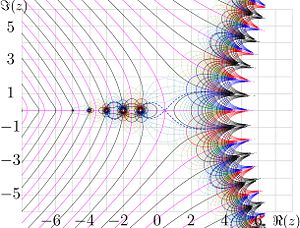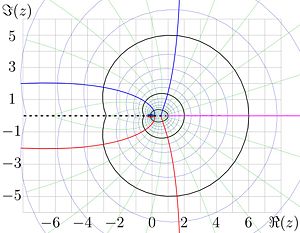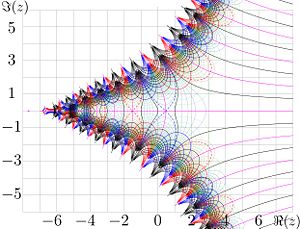Factorial: Difference between revisions
imported>Dmitrii Kouznetsov m (style) |
imported>Dmitrii Kouznetsov (entire function 1/z!, picture) |
||
| Line 51: | Line 51: | ||
The figure shows the mapping ot the [[complex plane]] with the factorial function. In particular, factorial maps the unity to unity; | The figure shows the mapping ot the [[complex plane]] with the factorial function. In particular, factorial maps the unity to unity; | ||
two is mapped to two, and 3 is mapped to 6. | two is mapped to two, and 3 is mapped to 6. | ||
==Function <math>f(z)=1/z!</math>== | |||
[[Image:OneOverFactorial.jpg|300px|right|thumb|<math>f(z)=\frac{1}{z!}</math> in the complex <math>z</math>-plane.]] | |||
The inverse funciton of factorial, id est, <math>\mathrm{ArcFactorial}(z)=\mathrm{Factorial}^{-1}(z)</math> from the previous section, sohuld not be confused with | |||
<math>f(z)=\frac{1}{z!}=\mathrm{Factorial}(z)^{-1}=\frac{1}{\mathrm{Factorial}(z)}</math> | |||
shown in the figure at right. | |||
The lines of constant <math>u=\Re(f(z))</math> and | |||
the lines of constant <math>v=\Im(f(z))</math> are drawn.<br> | |||
The levels <math>u=-24,-20,-16,-12,-8,-7 .. 7,8,12,16,20,24</math> are shown with thick black lines.<br> | |||
The levels <math>v=-24,-20,-16,-12,-8,-7 ... 7,-1</math> are shown with thick red lines.<br> | |||
The level <math>v=0</math> is shown with thick pink line.<br> | |||
The levels <math>v=1,2, ... 7,8,12,16,20,24</math> are shown with thick blue lines.<br> | |||
Some of intermediate elvels <math>u=</math>const are shown with thin red lines for negative values and thin blue lines for the positive values.<br> | |||
Some of intermediate elvels <math>v=</math>const are shown with thin green lines.<br> | |||
The blue dashed curves represent the level <math>u=1/\mu_0</math> and correspond to the positive local maximum of the inverse function of the real argument.<br> | |||
The ref dashed curves represent the level <math>u=1/\mu_1</math> and correspond to the negative local maximum of the inverse function of the real argument.<br> | |||
<math>f(z)=\frac{1}{z!}</math> is [[entire function]] that grows in the left hand side of the compelx plane and quickly decays to zero along the real axis. | |||
==References== | ==References== | ||
* {{cite book | author=Ronald L. Graham | coauthors=Donald E. Knuth, Oren Patashnik | title=Concrete Mathematics | publisher=[[Addison Wesley]] | year=1989 | isbn=0-201-14236-8 | pages=111,332 }} | * {{cite book | author=Ronald L. Graham | coauthors=Donald E. Knuth, Oren Patashnik | title=Concrete Mathematics | publisher=[[Addison Wesley]] | year=1989 | isbn=0-201-14236-8 | pages=111,332 }} | ||
Revision as of 22:06, 18 January 2009
In mathematics, the factorial is the meromorphic function with fast grow along the real axis. Frequently, the postfix notation is used for the factorial of number . For integer values of , the factorial, denoted with , gives the number of ways in which n labelled objects (for example the numbers from 1 to n) can be arranged in order. These are the permutations of the set of objects. In some programming languages, both n! and factorial(n) , or Factorial(n), are recognized as the factorial of the number .
Integer values of the argument
The factorial can be defined by a recurrence relation. If n labelled objects have to be assigned to n places, then the n-th object can be placed in one of n places: the remaining n-1 objects then have to be placed in the remaining n-1 places, and this is the same problem for the smaller set. So we have
and it follows that
which we could derive directly by noting that the first element can be placed in n ways, the second in n-1 ways, and so on until the last element can be placed in only one remaining way.
Since zero objects can be arranged in just one way ("do nothing") it is conventional to put 0! = 1.
The factorial function is found in many combinatorial counting problems. For example, the binomial coefficients, which count the number of subsets size r drawn from a set of n objects, can be expressed as
The factorial function can be extended to arguments other than positive integers: this gives rise to the Gamma function.
Stirling's formula
For large n there is an approximation due to Scottish mathematician James Stirling
Inverse function
Inverse function of factorial can be defined with equation
and condition that ArcFactorial is holomorphic in the comlex plane with cut along the part of the real axis, that begins at the minimum of factorial of the real argument and extends to . This function is shown with lines of constant real part and lines of constant imaginary part .
Levels are shown with thick black curves.
Levels are shown with thin blue curves.
Levels are shown with thick blue curves.
Level is shown with thick pink line.
Levels are shown with thick red curves.
The intermediate levels of constant are shown with thin dark green curves.
The ArcFactorial has the branch point ; the cut of the range of holomorphizm is shown with black dashed line.
The figure shows the mapping ot the complex plane with the factorial function. In particular, factorial maps the unity to unity; two is mapped to two, and 3 is mapped to 6.
Function
The inverse funciton of factorial, id est, from the previous section, sohuld not be confused with
shown in the figure at right.
The lines of constant and
the lines of constant are drawn.
The levels are shown with thick black lines.
The levels are shown with thick red lines.
The level is shown with thick pink line.
The levels are shown with thick blue lines.
Some of intermediate elvels const are shown with thin red lines for negative values and thin blue lines for the positive values.
Some of intermediate elvels const are shown with thin green lines.
The blue dashed curves represent the level and correspond to the positive local maximum of the inverse function of the real argument.
The ref dashed curves represent the level and correspond to the negative local maximum of the inverse function of the real argument.
is entire function that grows in the left hand side of the compelx plane and quickly decays to zero along the real axis.
References
- Ronald L. Graham; Donald E. Knuth, Oren Patashnik (1989). Concrete Mathematics. Addison Wesley, 111,332. ISBN 0-201-14236-8.


































